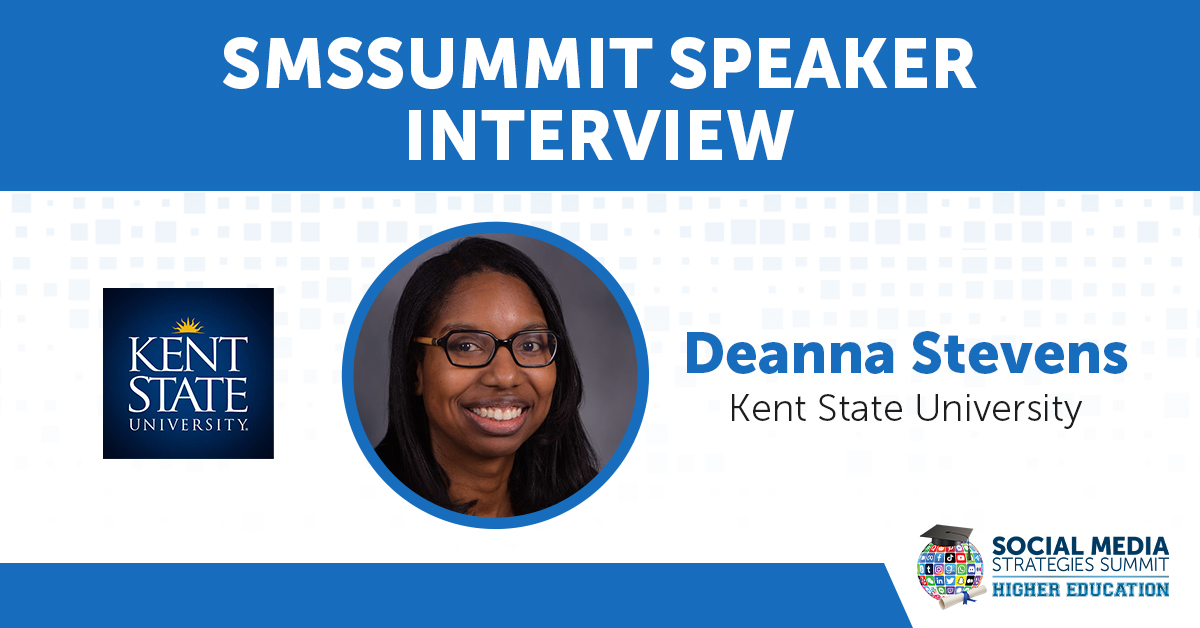Deanna Stevens Ulrich serves as the Social Media/Community Manager within University Communications and Marketing at Kent State University. She is responsible for managing the university’s institutional accounts, along with assisting with developing and implementing the strategy for the university and presidential social media presence. Check out our interview with her in anticipation of the upcoming Social Media Strategies Summit for Higher Education.
Please briefly describe the structure of your team. How many people are on your team, and where does it sit within the university?
The social media team consists of two full-time employees – my director and myself. Each semester we have 3-4 student employees as well. We are a part of the content team within the university’s centralized Division of University Communications and Marketing.
What will you be speaking about at SMSsummit Higher Ed?
My session is a panel discussion about building a social media content calendar. I started my career in journalism, so my background is in content and storytelling. I love developing content plans and finding the best way to present information. Everything from the messaging, visuals, and platform placement is just a piece of a larger communications picture.
Give us an overview of your role and what it entails daily.
I am the social media/community manager for University Communications and Marketing, meaning I manage the university’s institutional accounts and the internal social media community across Kent State. And I know this is so cliche, but every day is so different.
I’ve been in my role for over three years, and you never quite know what will be in store for you on any given day. Some days are more focused on content planning and production; others are heavier on customer service and account management. Sometimes my focus is on working with my colleagues across the university in a community management capacity. And of course, there are times when something happens (either on campus or nationwide), and the priority becomes crisis communications. You have to be ready for anything.
What do you love about your job?
I love the opportunity to be creative and collaborate with my colleagues. Recently we had the chance to work with the marketing teams within our Athletics Department and School of Theatre and Dance to create a superhero character for our mascot (Flash) for Halloween. A group of theatre students designed and built the costume, and we had a blast shooting a special reveal video unveiling Kent State’s own superhero – Super Flash. Not only did we have some fun content for Halloween, but we’ve also leveraged this character for other branding opportunities, community relations, and student engagement.
What’s the hardest thing about your job?
It’s no secret that social media management is quite a grind. From being on call 24/7 to dealing with some very serious issues regularly, this job can be hard on anyone mentally, emotionally, and even physically. The hardest thing about my job is ensuring I check in with myself and going offline to regroup as needed.
Please describe one of your institution or organization’s social media campaigns that makes you proud.
I’m proud of the Super Flash campaign that I mentioned earlier. We’ve had so much fun with this project and found creative ways to incorporate this character into our content. For example, Super Flash saved the day for our students with some tips for crushing finals week.
I’ve also been proud of our projects highlighting students on campus. We’ve done a great job of leveraging trends across higher education and the individual social media platforms to showcase what it’s like to be a student at Kent State. A few examples have been our day-in-the-life videos, which have been popular industry-wide, and a “What are you listening to” man-on-the-street style TikTok that earned 134,000 views and 17,000 likes making it our best performing TikTok to date.
Which social media channel is your favorite and why?
This is a tough one! Professionally, my favorite social media channel is Instagram. I like it the most from an audience engagement standpoint and because it is very user-friendly. Personally, I lean toward TikTok. There’s just a level of creativity on TikTok that I enjoy. (And I’ve also found some amazing meal recipes and book recommendations!) ?
What’s one piece of advice you’d give to a professional interested in starting a social media marketing career?
I would advise focusing on the strategy behind your organization’s online presence. When you have a clear vision of the goal(s) at hand and the audience you are trying to reach, it is so much easier to tailor your content to achieve those goals.
What’s one other higher ed institution that inspires you on social media, and why?
There are so many phenomenal higher education social media teams. It’s so hard to narrow it down to just one! I’d say some that inspire me are Ohio State, the University of Michigan, and West Virginia. Each school does a great job with branding; the content is visually stunning, and they always seem to have the best caption copy.
What are some of your favorite tools to do your job more effectively?
I’ve used Hootsuite for the past three years in this role, which has helped me manage the university’s accounts more effectively. We’re also lucky to have a fantastic creative team within my division, so we rely on their expertise quite a bit. But if I’m in a pinch, Canva is helpful for small design projects, and Animoto is a great platform for creating quick videos.
I also think it’s important to keep up with trends across the industry as much as possible, so I love to keep an eye on outlets like the Social Media Examiner and Social Media Today. The #HigherEdSocial Facebook group is also a fantastic resource for ideas, inspiration, and just about anything!
Looking forward to 2023 and beyond, what opportunities excite you most about higher ed social media?
I’m excited to see how technology will impact social media across higher education. Something that comes to mind, in particular, is augmented and virtual reality. I think we’ve only started to scratch the surface of how we can use AR and VR within social media and general communication strategies in the future.










